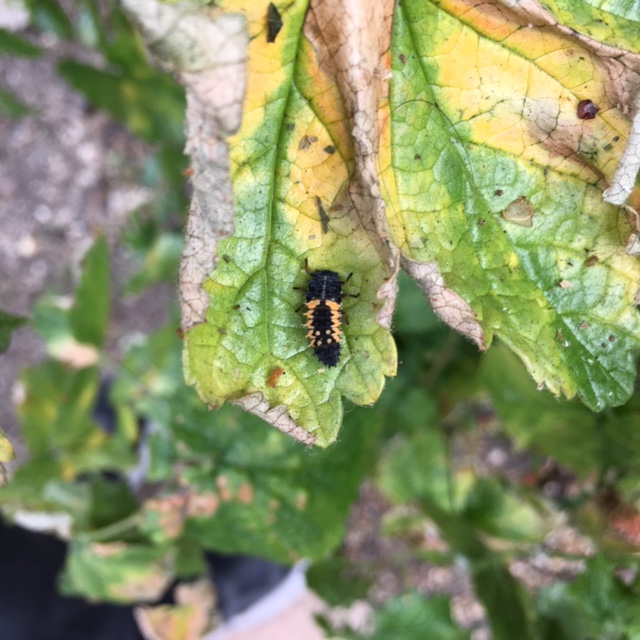This year, Garden 101 has had a major aphid problem. In 2019, the whitecurrant bush suffered hugely, so much so that the result was around three whitecurrants. I was keen to avoid a repeat; however, they’re back in force and I almost relived the currant trauma with the redcurrants this year, but ladybirds have saved the day.
Aphids are little sap-suckers that tend to target new growth. The eggs usually overwinter on a tree or shrub, with the new baby aphids feeding on the soft new growth when they hatch in the spring. When this new growth turns woody, they head on over to another, non-woody, plant to continue feeding, but are usually put back under control by predators by around mid-summer.
You’ll spot an aphid infestation either by seeing them on the underside of leaves or when the leaves of the plant start to turn crinkly, and your plants might lose their vigour. This is how I spotted the redcurrant situation – the leaves were looking very sad, which led me to check underneath them. Hundreds, if not thousands of tiny green aphids, sucking the life out of my plant. They secrete something called honeydew, which makes the plant incredibly sticky. Overall, it’s quite a grim picture.
They have a range of predators including lacewings, some wasps and, of course, the ladybird. Equally, they do have some friends and are often ‘farmed’ by ants! The ants like to eat the honeydew produced by the aphids and will often consume it, return to their nest and regurgitate it for the queen or other workers. In exchange for the honeydew, the ants keep the aphids together and help protect them from predators. The National Trust for Scotland has a video of this happening here.

Looking for a non-chemical solution to the aphid infestation, I came across a company that sold ladybird larvae. Who doesn’t like ladybirds? That’s right – no one, so I bought 50 ladybird larvae and had them posted to my house. It’s worth pointing out that the ladybirds I bought are the UK-native species and it’s really important to ensure that you buy the same. You can also use an organic pesticide (one that uses natural ingredients) to remove your aphids, but I found this significantly less effective than the ladybirds.
I do recognise that it’s incredibly odd to have a living creature posted to your house, but they came quickly and in a little box full of ladybird food. They seemed quite untroubled by their journey (though I have to admit that I don’t know what a troubled ladybird larvae might look like) and I made sure I got them out on the day they arrived, during the cool evening as it explains in the instructions, and popped them in the redcurrant bush in their release bag with some extra food. You can see me distributing the larvae in the video at the top.

Within a week, I started seeing the ladybird larvae crawling over the redcurrant bush. If nothing else, it’s fascinating to see how they change over time and become the ladybirds that we expect. After a couple of weeks, I started seeing a real decline in the number of aphids in the redcurrant bush and four to five weeks later, the aphids were gone. Today, I harvested 1.25kg of redcurrants. That’s less than last year when we had 2kg, but given how sad the bush looked, I’m happy nonetheless.
It has occurred to me that the ladybirds have just moved on to something more succulent, but the bush is surrounded by peas, wild flowers and rhubarb, none of which have aphids all over them. The remaining aphids are now at the other end of the garden on the new shoots of the apple trees and the courgettes. One hundred more ladybird larvae have now been released in these areas to help.

There are a number of other ways you can control aphids. You can squash them or wash them, using water or, as some gardeners do, a weak mixture of washing up liquid and water. This needs to be sprayed on every two-three days for two-three weeks. I have read of some people using a garlic wash, as aphids are known to be repelled by garlic. I’ll be trying both of these solutions, in addition to the ladybirds. I have even read one suggestion of covering aphid infested plants in flour, because it constipates them! I might not try that one, to be honest.
Whichever solution you use, it will be easier to tackle them at the very start of spring rather than when they have established themselves, but I suggest that you give it a go at any time. They are all better than putting chemicals on your garden!
To finish, I would like to reference the Royal Horticultural Society (RHS) from where I have gained most of my knowledge on aphids. I would also like to point you towards www.greengardener.co.uk, where I buy my ladybirds. Please note that this is not a paid link – in fact, they probably don’t even know I recommend them – but I’ve had a great experience with them and they have a range of natural products for different solutions.

1 thought on “Using ladybirds to control aphids”